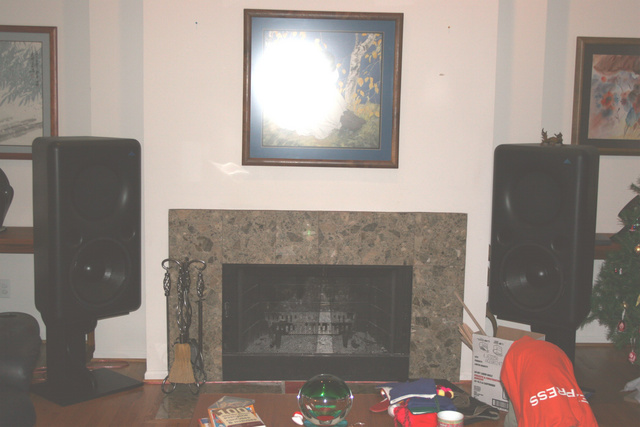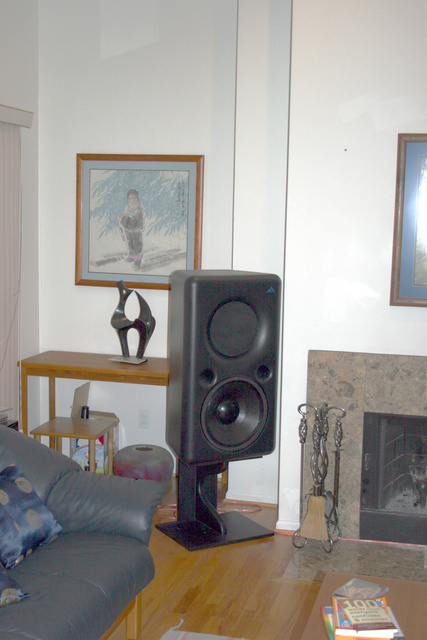I recently had the opportunity to visit Dr. Geddes in the greater Detroit area while spending the holidays with my wife's family. I do not believe Dr. Geddes reads this forum, but I'd like to thank him and his wife for allowing me a great opportunity to hear his work in action.
Dr. Geddes's website can be found here,
www.gedlee.com. You can find out a little about his lengthy resume by poking around on his site. However, most of us have probably heard Dr. Geddes's name when the topic of waveguides came up. He has published many works in the JAES on the subject. He has also written on distortion and human hearing and developed measured that better relate the two.
Dr. Geddes has designed a speaker system based on his concepts named the Summa, as in Summa Cum Laude. I had the opportunity to hear the Summa in both of Dr. Geddes's untreated living room two channel system, and his fully treated HT room both in two channel and multichannel.

I loved the dynamics of the Summas, never have I heard dynamics like these before. When we were listening at extremely high levels, it didn't sound that loud (Geddes ideas of distortion at work here?). I could think of no better HT/Rock/large-scale-orchestral speaker. These are pretty far from a typically audiophile 2-way.
Dr. Geddes played a live Cream dvd that was off the hook. We were playing at 110db (c-weighted) and there was zero compression what-so-ever. It really did sound like you were in the audience. Large scale orchestral (Exotic Dances, Eijie Ouie, Ref Rec.) was played with major authority. Details were all there but not overemphasized, plenty of seperation but not dissected. Definitely a mid to rear hall perspective.
My own RM40s have a lot more dynamics and low end and "able to play loud without compression"-ness than most other audiophile speakers, but the summas were on a complete other level. Maybe this is why some still are entrounched in the hi-eff camp. I think Dr. Geddes said the Summa was ~97db/w. This really reminded me of the Selah Arrays in terms of dynamics, lack of compression and low distortion. The difference being point source versus line source.
There was also no honking or aggressiveness like a typical Klipsch speaker would have. In fact, Dr. Geddes mentioned that major pro audio corp (that I'll leave nameless) is in talks with him about his technology, as they have never been able to produce a horn/waveguide without the honking in well over 50 years of being in the business. I believe that science really can benefit this hobby if we are willing to take a couple of steps back and look at what assumptions are in the current yardsticks.

Dr. Geddes is a non-believer in electronics. Upstairs in his 2 channel system in an untreated room (about as bad as mine) he had ~$200 in total electronics (sony changer into pioneer receiver iirc). Some cuts played on this system sounded quite good and surprising for such a bad room and mid-fi gear, while others had me scratching my head. I heard on a couple tracks played, some overblown midbass, which I am not sure was due to room, electronics or speaker tuning. Dr. Geddes commented that the tracks were poorly recorded, which is probably true, but I still haven't heard that problem on any other speaker I have listened to these tracks on.
Downstairs is another story altogether. Dr. Geddes has an excellent HT room, sound proofed, full treated to his specs and overall an excellent listening environment. I am seriously jealous of such a room. We listened to both 2 channel and multichannel material. I played a couple of the same tracks I had played upstairs, but not the really problematic track. I never noticed the midbass problem down in this room. Electronics down here are a HTPC into a Pioneer receiver.
I played a whole bunch of great tracks I use for testing systems and a few that the rave group uses at each GTG to make comparisons easier. Things sounded excellent overall. Plenty of depth of field perspective. Sound stage was reasonably wide for such a typical narrow room. Imaging was centered but not razor sharp IMO. Imaging was a bit better higher up than lower down in the vocal range, again IMO. The overall voicing of Dr. Geddes speakers was mid to rear hall (something like 3/4 back).
The midrange was there, plenty of details but not quite as pronounced as more audiophile speakers protray, particularly in the upper midrange. To me this made them sound a bit more natural, but definitely a bit different than a lot of what I am use to hearing a lot of. This could also be a pyschoacoustic affect of having more bass power at higher volumes than I am use to, it could also be that the 15" woofer is not as resolving in its upper range as a typical 6.5" two way monitor. This was one of those things that had me puzzled. I definitely didn't dislike it, but it was different. Not your typical jazz lover speaker.
Overall, I came away really wanting to experiment with the WG's more and also to try a hi-eff project at some point. I seriously loved the dynamics and lack of compression, it was a breath of fresh air.[/img]